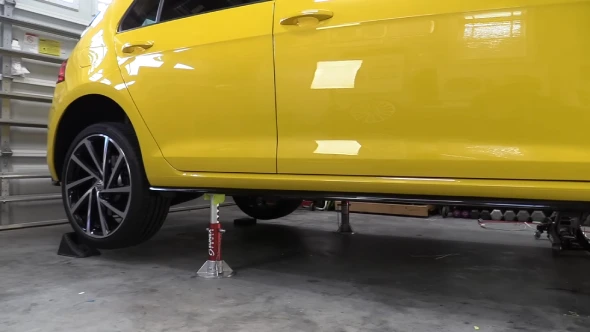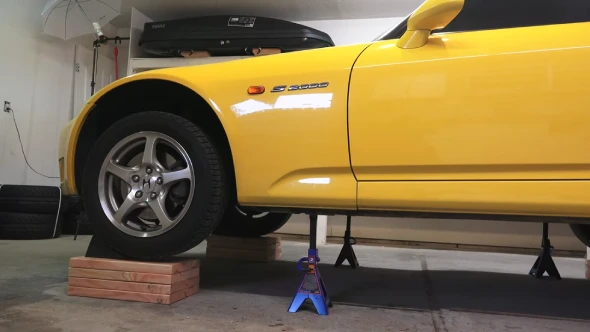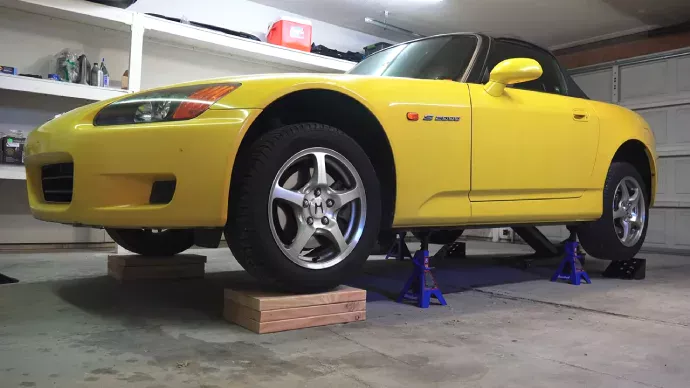Last Updated on April 17, 2023
Are you looking to jack up your car overnight or even longer? Whether it is an oil change, tire rotation, engine repairs, or simple storage over a long period, having your car supported by jack stands can be a great solution. But how long can you leave a car on jack stands?
You can leave your car on jack stands overnight to keep it safe, but if not done right, it could spell disaster. The right tools and materials are crucial if you want to leave your car on jack stands for a long time. Ensure all parts are secure, take care of the wheels and axles, and lift the vehicle properly.
Follow these steps carefully, and your car will stay up on jack stands until you’re ready to drive again. Here are the most critical steps you need to take to keep your car on jack stands safely.
How Long Can You Leave a Car on Jack Stands: 4 Steps

If you’re preparing to work underneath your vehicle, one of the most important safety practices is to raise the car off the ground. To do this, you’ll need a set of quality jack stands. Here are the steps to take when lifting your car up on a set of jack stands:
Step 01: Gather Necessary Tools and Materials
- First and foremost, when setting up your car on jack stands, you need the proper tools and materials. The most important items are jack stands, a jack (hydraulic or scissor), wheel blocks/chocks (optional), wrenches, pliers, or other necessary tools.
It’s also a good idea to have a floor mat or cardboard to place underneath the car, an owner’s manual (if available), and safety glasses and gloves.
- Jack stands come in many different sizes and shapes, so make sure that you purchase ones that are appropriate for your vehicle’s weight and size. Jack stands should always be placed on a solid, flat surface like concrete or asphalt. Never use them on dirt or sand.
If you’re doing more extensive work on your car, such as replacing brakes or suspension components, you may want to consider using wheel blocks/chocks for additional safety.
- Aside from proper equipment preparation, there are some other safety precautions you should take before getting started. Make sure you dress appropriately for the job. Wear long pants and closed-toe shoes if possible.
Also, try to keep the area clean of any debris or clutter that could get in the way of your workspace. And above all else: never get underneath a vehicle supported only by a jack. Make sure to double-check that all of your jack stands are secure before getting beneath your car.
Step 02: Preparing the Vehicle for Lifting and Jacking Up
Once you have your tools and materials ready, it’s time to begin lifting the vehicle and putting it on jack stands. Start by engaging the parking brake and shifting into first/reverse gear (or park mode if you have an automatic transmission).
Then place wheel blocks/chocks in front and back of tires opposite of the side you’re lifting from so that your car can’t roll off jack stand(s) while being jacked up.
If you are working on a concrete or asphalt surface, you should place a floor mat or piece of cardboard under the vehicle. This will help to minimize damage from leakage and protect your jack from being accidentally damaged by scraping on hard surfaces while you are jacking up the vehicle.
Step 03: The lifting and Positioning Jack Stands Under the Vehicle
With the right tools, materials, and vehicle preparation, you can lift and position your vehicle using a hydraulic floor jack or scissor jack.
Start by locating the designated jacking points in your owner’s manual or by looking underneath the vehicle’s frame structure. Make sure these points are free of debris before proceeding with any jacking up of the vehicle.
Carefully raise the vehicle off the ground, making sure to use an appropriate level of force depending on which type of jack is being used. Once you have reached your desired height, place both jacks and stands underneath the frame rails of the vehicle where instructed in the owner’s manual.
Use wrenches if necessary to adjust the height of each jack stand as needed. Lower the car onto them, and double-check that they are securely positioned beneath frame rails before lowering it down completely.
You may need to adjust their heights with wrenches further if needed, but always make sure that they are firmly resting beneath frame rails for a secure hold.
Once all connections between jacks and frame rails are fully secure, slowly begin releasing pressure from hydraulic floor jacks until the car is fully supported only by jack stands alone.
When you do so, be sure that nobody is standing underneath the vehicle when removing hydraulic floor jacks cause safety always comes first.
Step 04: Finishing Touches
To finish off the job properly, double-check that your car is securely supported on both sides, with all four wheels slightly elevated off the ground. Take the time to test out the parking brake and gear shift lever to ensure there’s no unexpected movement.
If you plan on leaving your vehicle unattended for an extended period, consider covering any exposed parts with a thick cloth or a plastic sheeting material. Store away any tools and materials you use for safekeeping until next time, and make sure to dispose of any discarded fluids in accordance with local ordinances.
Lastly, it is important to ensure that all occupants understand how hazardous it can be when cars are left in lifted positions without taking due precautionary measures.
Maintenance and Inspection of a Car Jack Stands

Proper maintenance and inspection of car jack stands are absolutely essential to avoid any unwanted accidents. Before each use, make sure to check for any signs of wear or damage that could compromise its integrity.
Inspect the metal surfaces for corrosion, as this can weaken them over time. Also, look for cracks, chips, and dents in the material. If any of these are observed on the jack stand surface, do not try to use it until you have replaced it with a new one.
When using car jacks and jack stands, ensure that they are properly set up on a flat-level surface before lifting your vehicle off the ground. If you find yourself operating in an uneven environment, take extra precautionary steps, like placing a board beneath each corner of the vehicle to ensure stability while being lifted up into the air.
Also, make sure never to exceed their maximum weight rating. This could lead to jack stands structural failure or instability while handling large vehicles such as vans or SUVs.
Are Jack Stands Safer Than a Jack on Your Car?
Jack stands to provide much more stability and safety than a jack alone. They are designed to support the weight of your vehicle while you work on it, allowing you to raise the car off the ground safely.
They also come in different sizes and weights, so you can choose one that is appropriate for your vehicle. And some of them have an adjustable height feature that allows you to customize the height of the stand to fit your specific needs.
In contrast, jacks are not as secure or stable as jack stands. They are often used as temporary solutions for changing tires or performing minor repairs but should never be used for any major repair work. Jacks can easily slip or move out of place, leading to severe injury or even death if not used properly.
Therefore, it is always best practice to use jack stands when working on your car instead of relying solely on a jack. Their added stability and security features will help keep you safe while you work on your vehicle.
Are Jack Stands Safer Than Ramps for Cars?

When working on your car, jack stands are generally a safer option than ramps. The use of ramps can be both convenient and risky if they are not used correctly, especially when changing tires or working on short-term projects.
Unlike jack stands, which are designed to hold up your vehicle as you work on it securely, ramps only act as a platform for the tires and offer much less stability. On uneven surfaces, such as dirt or gravel, slopes or uneven ground can cause the ramp to shift and become unstable when in use.
Jack stands are typically more secure than ramps because they are adjustable and can be adjusted to fit various sizes of vehicles. They also come with safety locks to prevent them from slipping or sliding out of place when in use.
Also, when using jack stands, you always have the added benefit of elevation. This allows you to safely lift your vehicle off the ground so that you can work on specific components such as brakes and suspension systems. Ramps do not provide this same level of safety by elevating your vehicle off the ground.
For these reasons, it is always recommended to use jack stands instead of ramps when working on your car for any type of repair work.
How Do I Put a Car With Jack Points on 4 Jack Stands?
Putting a car on four jack stands is an important part of any DIY maintenance or repair job. It is essential to ensure the safety of yourself and your vehicle by following the proper steps. Here’s how to put a car on four jack stands:
- Read your car’s manual for any specific instructions about jacking up your vehicle.
- Make sure you park your car on a flat surface before beginning the process of jacking it up.
- Place wheel chocks around the wheels that will remain on the ground so that they don’t move while you’re working.
- Before lifting your car, loosen all of the lug nuts on each wheel with a tire iron or socket wrench so that it will be easier to remove them later when you need to change tires or brakes.
- Use a hydraulic floor jack to lift one corner of the vehicle at a time until it is high enough for you to place jack stands underneath each wheel safely and securely.
- Place one jack stand under each wheel, ensuring they are secure and stable before releasing pressure from the hydraulic floor jack and allowing it to rest completely on top of them.
- Once all four wheels are resting on the jack stands, use a tire iron or socket wrench to remove each lug nut completely. Lift each wheel off of its stand in order from front to back, starting with the left side first and then moving onto the right side second.
By following these steps carefully, you can safely put your car on four jack stands to perform necessary maintenance or repairs without danger.
Safely Park Your Car on Jack Stands

Leaving a car on jack stands is an effective way to park your vehicle while performing maintenance activities or just storing it away for extended periods. Of course, safety must always be paramount when using this approach.
If you want your car to stay up on jack stands, ensure you have the right tools and materials, prepare each wheel before jacking them up, use jack stands that are the right size for your car’s weight, and fasten everything securely. Then you can have peace of mind knowing your car will be safe.
So, with the right precautions and care, your car can be left on jack stands for as long as necessary. Double-check everything before leaving it unattended, and get back to working on your vehicle when ready.
